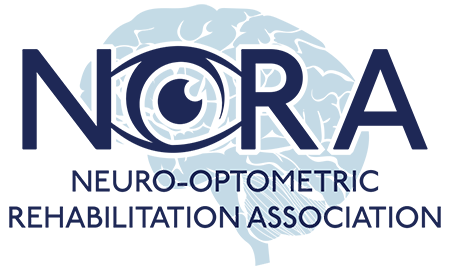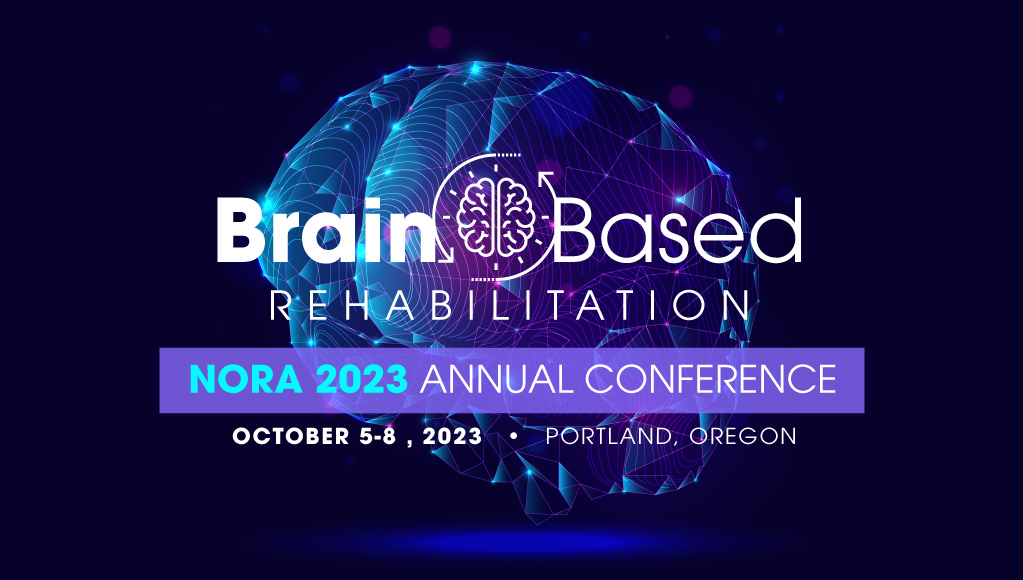2023 Annual Conference
Thursday, October 5
Morning sessions will run from 8:00 AM – 11:30 AM (with ½ hour break). Lunch will be served from 11:30 AM until 1:00 PM. Afternoon sessions will run from 1:00 PM – 4:30 PM (with ½ hour break). Exhibit Hall will open at 4:30 PM and Welcome Reception will run from 5:00 PM – 7:00 PM. Student reception at 7:30 PM
Foundations of Neuro Optometric Rehabilitation (a.k.a. Clinical Skills Level 1)
- Katy Coleman, OTR/L
- Melissa Zarn, OD, FAAO
- Xenia Andrzejewski, PT
- COPE Course ID: 86234-NO (Morning session – part 1)
- Qualified Credit: 3.00 hour(s)
- COPE Course ID: 86235-FV (Afternoon session – part 2)
- Qualified Credit: 3.00 hour(s)
This course will provide a foundational understanding of the role of neuro-optometric rehabilitation for vision disorders associated with neurological impairment. An overview of structure to function mapping in the brain, visual processing and the impact of neurologic impairment, and the key components of Neuro Optometric Rehabilitation (NOR) will be reviewed. This course is designed to introduce key concepts in NOR to practitioners who have limited experience with NOR. This course will also benefit anyone starting the NORA Fellowship process preparing to complete the Level 1 open book questions and NORA concepts presentation.
Clinical Applications of Neuro Optometric Rehabilitation (a.k.a. Clinical Skills Level 2)
- April Spurling, OD
- Raquel Munitz-Goldfeder, MS
- Vincent R. Vicci, Jr., OD, DPNAP, FNORA
- COPE Course ID: 86663-FV (Morning session - Part 1)
- Qualified Credit 3.00 hour(s)
- COPE Course ID: 86664-FV (Afternoon session - Part 2)
- Qualified Credit 3.00 hour(s)
This course will expand your ability to implement treatment for patients who present with neurologically based vision challenges. A series of case histories including the patient’s history, initial evaluation, diagnosis, treatment plan and therapy program will be reviewed. You will leave feeling more proficient and confident with beginning or continuing to treat those who will benefit from Neuro-Optometric Rehabilitation.
Extended Concepts in Neuro Optometric Rehabilitation (a.k.a. Advanced Clinical Skills)
Concussions, neurofunctional disorders and interdisciplinary therapeutic interventions
- Kyla Demers M.Sc., CAT(C), Ost.
- Janie Guimond B.Sc, O.T.
- COPE Course ID: 86665-FV (Morning session - part 1)
- Qualified Credit: 3 hour(s)
- Pending: 3 hours COPE Accredited Education in PM
This workshop will explore a balance of theory and therapeutic interventions regarding aspects of health, concussions and chronic disorders. Furthermore, we will explore the intimate relationship between the systems and how combining therapies can be beneficial on multiple levels.
4:30 PM – 7:00 PM
Exhibit Hall will open at 4:30 PM/Welcome Reception starts at 5:00 PM
7:00 PM – 8:30 PM
Level 3 NORA Fellowship Writing Workshop
Dr. Kenneth Ciuffreda will hold an informal discussion with a small group of invited candidates who have reached Level 3 reviewing how to write a quality paper in order to successfully fulfill the NORA fellowship final requirements.
7:00 PM – 9:00 PM
Student reception
Friday, October 6
7:30 AM – 9:10 AM
It Takes a Village – Multidisciplinary Management of Persistent Symptoms Post Concussion
- Shannon McGuire,BHSc
- COPE Course ID: 86610-NO
- Qualified Credit: 2 hour(s)
There are new diagnostic criteria for concussion from the American College of Rehab Medicine and the 6th edition of the Consensus Statement on Concussion in Sport. How we assess and manage TBI is changing with due to new research and a better understanding of causes of symptoms and how to manage them. This talk will highlight the latest research in management of mild traumatic brain injuries with a focus on individuals with persistent symptoms. It will review a systems framework for classifying and prioritizing clinical presentations in order to help ensure proper assessment and management including determining what team members should be involved and how to work together in a cohesive way with the patient at the center.
BREAK 9:15 AM – 10:15 AM (Exhibit Hall open)
10:20 AM – 12:00 PM
Neuro-Visual Processing Therapy: Interdisciplinary Treatment Approach for TBI, including Congenital Disorders Normal and Abnormal Neuro Motor Development
- Raquel Munitz-Goldfeder, MS
- April Spurling, OD
- Mario Marroquin, BS
- COPE Course ID: 86609-FV
- Qualified Credit 2.00 hour(s)
This course will demonstrate how vision can affect movement and postural relationships and how Neuro-Visual Postural Therapy (NVPT) can affect posture, movement, and spatial orientation. Participants will learn the basic concepts of development and movement from birth to performance against gravity. We will cover functional definitions in normal and in abnormal development, concepts of normal and abnormal reflexes, and how, during development, they provide the basis for gross and fine movements. Participants will have an opportunity to observe and try different approaches to assess stages of development and signs of abnormality. Emphasis will be placed on the need for and benefits of interdisciplinary approaches to help patients with neurological dysfunction.
LUNCH 12:00 PM – 1:30 PM (Exhibit Hall open)
1:30 PM – 2:00 PM
Use of Performance-Tinted Contact Lenses in Patients with Photosensitivity
- Amanda Nanasy, OD
- Eric Sugarman, ATC
- Michael Hull, BS
- This course is not for COPE credit. Sponsored by ALTIUS
 Photosensitivity, also referred to as photophobia, is commonly associated with migraine headaches, concussion, traumatic brain injury, and various other systemic and ocular conditions, and can often be debilitating and prevent normal daily function. Research has demonstrated that photophobia symptoms can be marginally relieved by eyewear with specific filters. However, the intrinsic features of spectacle mounted tints often limit their effectiveness in reducing such symptoms due to environmental, optical and visual factors, while also presenting practical use limitations for the wearer exposed to varying light conditions both indoors and outdoors. Integration of engineered tints uniformly into single-use soft contact lenses that block 100% of UV, absorbs more than 99% of Blue Light, selectively filters wavelengths above 500nm, and provides total tint immersion for the patient, results in a much improved solution for the eyecare practitioner to treat and manage patients suffering from Photosensitivity.
Photosensitivity, also referred to as photophobia, is commonly associated with migraine headaches, concussion, traumatic brain injury, and various other systemic and ocular conditions, and can often be debilitating and prevent normal daily function. Research has demonstrated that photophobia symptoms can be marginally relieved by eyewear with specific filters. However, the intrinsic features of spectacle mounted tints often limit their effectiveness in reducing such symptoms due to environmental, optical and visual factors, while also presenting practical use limitations for the wearer exposed to varying light conditions both indoors and outdoors. Integration of engineered tints uniformly into single-use soft contact lenses that block 100% of UV, absorbs more than 99% of Blue Light, selectively filters wavelengths above 500nm, and provides total tint immersion for the patient, results in a much improved solution for the eyecare practitioner to treat and manage patients suffering from Photosensitivity.
2:00 PM – 2:45
Becoming A Nora Fellow
- Nancy Mackowsky, OD, FNORA
- This presentation is not for COPE credit
Being a specialist is a coveted route in the medical field. The NORA Clinical Skills/Fellowship Program was developed for the membership of NORA to develop and support the highest level of clinical abilities and scientific knowledge in the field of Neuro-Optometric Rehabilitation. It is not a certification process but rather a learning process to help the individual clinician develop deeper knowledge and understanding about Neuro-Optometric Rehabilitation with a multi-disciplinary approach. During this presentation, you will learn what is involved in becoming a fellow of the Neuro-Optometric Rehabilitation Association (FNORA) and how it can provide an added level of expertise, insight and experience to your practice.
2:50 PM – 4:30 PM
The Vestibular Influence on Vision and Performance
- Cedrick Noel, DC, DACNB
- COPE Course ID: 86272-FV
- Qualified Credit: 2.00 hour(s)
An innovative approach to engaging the 3 primary neurological systems simultaneously to recalibrate and "reset" a person's relationship with the ever-present force of gravity, thus improving results and encouraging the long-term adoption of any therapeutic procedure.
4:30 PM – 5:45 NORA General Mtg
4:30 PM – 7:00 PM
Talk & Trial (food/refreshments served)
Take advantage of this opportunity to spend dedicated time with our exhibitors, learning about and gaining first-hand experience with a vast array of products, programs, and services that can help you build and enhance your practice.
5:00 PM
Poster session Opens
6:00 PM – 9:00 PM
NORA Fellowship Presentations: Neuro-Optometric/Brain Injury Rehabilitation Lectures & Case Reports
- Moderators: Nancy Mackowsky, OD, FNORA, Tonya Umbel, OD, FNORA, Shirley Blanc, OD, FNORA, Cathy Stern, OD, FNORA and Derek Tong, OD, FNORA
- Presenters: Various NORA Fellowship Level 1 Candidates (10-12 minutes short lectures), Level 2 Candidates (18-20 minutes case reports)
- This course is FREE to all NORA attendees; no separate registration is required
- This course is not for COPE credit
- Lecture and case report topics will be posted at each of the 2 rooms on the day of the presentations
- Presenters check-in 6:00-6:15 pm
Saturday, October 7
8:00 AM – 8:50 AM
The Delightful Duo of Oculomics and Optometry
- Deborah Zelinsky, O.D.
- Founder of Mind-Eye Institute, Northbrook, IL USA
- COPE Course ID: 86236-NO
- Qualified Credit: 1.00 hour(s)
Learn about the emerging field of oculomics – a part of eye care’s future beyond central and peripheral eyesight. This hour emphasizes three points. 1) how we can further the field of optometry by studying connections between ocular biomarkers and overall health; 2) how lens prescriptions influence visualization, mood, metabolism, posture, space and time organization, in addition to sharpening eyesight;3) how to think about the unique “WHO am I?” brain filtering each person brings to the exam chair.
8:55 AM – 9:45 AM
“Seeing the Brain Through the Eye: What is Next for Neuro-optometry, Neuroimaging and Neurology Applications”
- Delia Cabrera DeBuc, Ph.D.
- Research Associate Professor of Ophthalmology, Bascom Palmer Institute, Miami, FL, USA
- COPE Course ID: 86273-NO
- Qualified Credit: 1.00 hour(s)
Investigating the eye-brain connections may unravel the relationship between the connecting pathways of neurons in the brain and the eye. This undertaking may help us to determine how vision impairment affects the brain and facilitate a better explanation of how changes in the brain might influence the outcome of potential therapeutic approaches targeting vision restoration. Connectomics is the science of mapping out connections, extensively used in brain research to obtain its wiring diagram to understand better patterns in brain connectivity.
Interestingly, determining the circuit diagram of the retina, considering that a little piece of neural tissue such as the photoreceptor segments sense light and send visual information to the brain, will be valuable to help to decode novel medical treatments yet undiscovered. Therefore, the idea that patients may respond to treatment differently based on how their eye-brain connections are wired and not only on the specific conditions of the eye disease is provocative and deserves attention.
This presentation overviews the eye-brain connectome and emerging human-computer interface technologies in neuro-optometry, neuroimaging, and neurology applications. It expresses our view about how these technologies could serve the above goals and open a window that could provide a direct view of the brain.
BREAK 9:50 AM – 10:50 AM (Exhibit Hall open)
11:00 AM – 11:30 AM
Neuroplasticity and the Vestibular System
- Dr. John Hatch DC, DACNB, FABBIR
- This course is not for COPE credit. Sponsored by Cognuro
Every patient has a vestibular imbalance. The Vestibular System is constantly activated by gravity. Better understanding gravity, the one constant in life, will help all practitioners to rehab the brain and find lasting solutions for our patients.

11:30 AM – 12:10 PM
Virtual Reality and Vision Processing and the Effect of Artificial Intelligence on Virtual Reality.
- Vahid Mohammadzadeh, M.D.
- This presentation will be pre-recorded and is not for COPE credit
Dr. Mohammadzadeh will discuss how the evolution of virtual reality would affect the visual processing of individuals who use virtual reality for training. He will further discuss how artificial intelligence would improve this task.
LUNCH 12:00 PM – 1:50 PM (Exhibit Hall open)
2:00 PM – 2:50 PM
Neurotrophins and their receptors in glaucoma
- Margaret Fahnestock, Ph.D.
- COPE Course ID: 86274-GL
- Qualified Credit: 1.00 hour(s)
Glaucoma causes loss of retinal ganglion cells (RGCs) and optic nerve damage, eventually leading to vision loss. The most common types of glaucoma are characterized by increased production or decreased outflow of aqueous humor, leading to increased intraocular pressure. The increased intraocular pressure is thought to lead to RGC death, although the mechanism of RGC death is not well understood. Current treatment strategies are focused on reducing intraocular pressure, however, often this does not mitigate the death of RGCs and optic nerve degeneration.
Loss of neurotrophic support may contribute to RGC death in glaucoma. In particular, the neurotrophins nerve growth factor (NGF) and brain-derived neurotrophic factor (BDNF) and their receptors are expressed by retinal neurons and glia and are required for the survival and function of RGCs. Levels of NGF and BDNF and their receptors are altered in glaucoma and in animal models of the disease, and ocular administration of NGF or BDNF can reduce RGC loss. The expression of neurotrophins and their receptors in glaucoma and in animal models will be discussed. The contribution of neurotrophins to glaucoma progression and treatment and current knowledge gaps will be highlighted.
3:00 PM – 3:50 PM
Assessing the complexity of visual processing to evaluate cognitive function and impairment using continuous recognition task
- James O. Clifford, PhD
- J. Wesson Ashford, MD, PhD.
- Pending: 1 hour COPE Accredited Education
This session will address the capacity of the visual system to perceive, encode, and recognize complex pictures, which is a process heavily dependent on neuroplasticity, which is progressively disrupted by aging and most forms of dementia. The continuous recognition task provides a platform which can estimate the function of this system within 2 minutes and be repeated at regular, even short intervals to screen and monitor memory function.
4:00 PM – 5:00 PM
The Eyes, The Ears, and A New Therapeutic Model for TBI Care
- Debby Feinberg, OD, FAAO
- Gerard Gianoli, M.D., F.A.C.S.
- COPE Course ID: 86238-FV
- Qualified Credit: 1.00 hour(s)
Join us as we introduce a Neuro-Visual Medicine approach to providing relief for individuals with traumatic brain injuries (TBIs) suffering from vestibular-type symptoms. We will lay the foundation by discussing the mechanics of balance and stability, and the crucial roles played by the visual and vestibular systems, and the pivotal role of the vestibular ocular reflex (VOR). By understanding a well-functioning balance system, we can more easily identify and understand the various types of dysfunctions. Through case studies, we will explore scenarios involving dizziness and imbalance caused by subtle vertical phorias, inner ear dysfunction, or a combination of both. Additionally, we will examine the therapeutic interventions utilized, as well as the measurements used to assess improvement. Our aim is to have this presentation encourage Neuro-Optometric clinicians to expand their prism practice and leverage it alongside active therapy for improved outcomes in TBI care.
5:00 PM – 6:30 PM
Level 3 NORA Fellowship Writing Workshop
Dr. Kenneth Ciuffreda will hold an informal discussion with a small group of invited candidates who have reached Level 3m reviewing how to write a quality paper in order to successfully fulfill the NORA fellowship final requirements.
Sunday, October 8
8:00 AM – 8:50 AM
Chronic Inflammatory Response Syndrome (CIRS): A Missing Link for Treatment- Resistant Patients?
- Doug Villella, OD
- COPE Course ID: 86240-SD
- Qualified Credit: 1.00 hour(s)
We all have patients who do not respond fully to neuro-optometric rehabilitation. Invariably, these patients have also had mixed results with multiple other standard and integrative therapies. This lecture will explore the the new science of Chronic Inflammatory Response Syndrome (CIRS) and it’s diagnosis and treatment as the missing link to the recovery of many of these treatment-resistant patients.
8:55 AM – 9:45 AM
Putting it all together: Structure and Function - research revealing retinal thinning with various conditions.
- Amy Pruszenski, O.D.
- COPE Course ID: 86242-NO
- Qualified Credit: 1.00 hour(s)
Thinning of retinal tissue in neuro-compromised patients, is a warning sign for imminent brain changes. Retinal thinning is found in very specific areas before brain atrophy occurs, according to recent studies on neurodegenerative diseases, such as Alzheimer’s and Parkinson’s, and several mental health disorders, such as bipolar and schizophrenia. Optometrists are in a prime position to help diagnose these conditions in younger populations, who would be needing more long term care.

